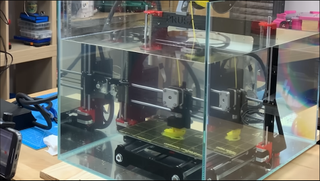Makers Build Underwater 3D Printer That Runs in Aquarium, Public Pool
3D printing underwater is surprisingly feasible, but comes with its own unique challenges and caveats

Ever wanted to see a 3D printer operate underwater? The guys over at CPSdrone and its corresponding YouTube channel certainly did, and they cooked up a full 17-minute video breakdown of the project to prove it.
To make a system capable of surviving underwater use, the CPSdrone men created a custom printer that appears that be based on a Prusa i3. They used various epoxies to waterproof different parts to prevent short circuiting and they replaced some metal parts that corrode quickly with plastic ones. They also chose to keep the display and the power supply out of the water.
After modification, the pair tested their 3D printer in a variety of underwater environments, including an aquarium and a public pool. They undertook a full week of testing before taking the 3D printer to the pool.
Before I embed the video below and break down some of the most pertinent information gained from it, I do want to make a disclaimer. While 3D printing underwater sounds a little silly, there are some actual benefits incurred with doing the process underwater. Cooling fans are no longer required to dissipate heat, which can lead to higher-quality prints.
This also isn't the first time underwater 3D printing has made its way into the headlines, though the applications here are much different. Back in 2021, Kongsberg Ferrotech spoke about its development of underwater 3D printing technology to be used for seabed pipeline repairs, not for consumer/prosumer 3D printers like the one covered in this article.
Let's not get sidetracked, though: how well does this underwater 3D printing solution from CPSdrone work? The full build process and breakdown is in the original 17 minute video embedded above, but I can still wrap up here with some quick takeaways.
The biggest takeaway is that 3D printing underwater does work (though you'd need to significantly modify even the best 3D printers), but doesn't fully live up to the hype of the video thumbnail (depicting a print inside a swimming pool). Unfortunately, that feat is actually outside of the range of what CPSdrone could achieve with this project, despite their efforts.

Prior to the pool testing, testing in an aquarium tank worked splendidly for an entire week. During pool testing, though, the engine starting having stuttering issues due to severe rusting, which would naturally accumulate in any underwater testing environment.
At the conclusion of the video, CPSdrone also discuss a few improvements that could make the process significantly more sustainable. "Waterproof motors" certainly make the list.
Stay on the Cutting Edge
Join the experts who read Tom's Hardware for the inside track on enthusiast PC tech news — and have for over 25 years. We'll send breaking news and in-depth reviews of CPUs, GPUs, AI, maker hardware and more straight to your inbox.
Most Popular




By Zhiye Liu

By Mark Tyson